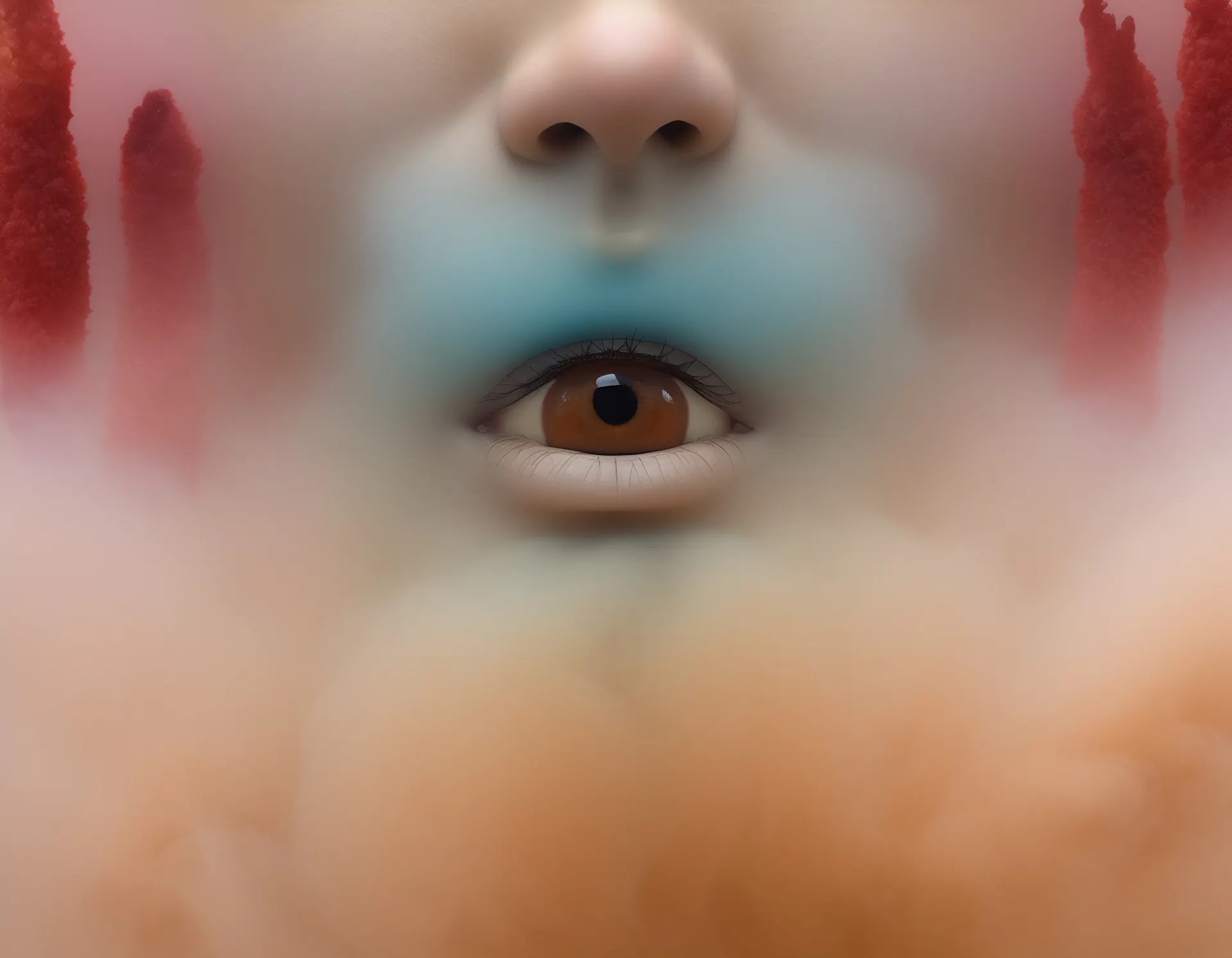August 2024
Art and DAOs
Artists have used DAOs to create autonomous AI artists, create self-referential critiques of the issue of collaboration that arises within them, and to enable a physical sculpture to self-perpetuate through cryptocurrency.
![]()
![]()
Botto is a decentralized autonomous artist, originating from an AI image generation model built by artist Mario Klingemann.
Members of the Botto DAO vote on the output of the AI, selecting which images should be put up for auction as NFTs. Half the proceeds from each sale go to the members who participated in that selection process, and the other half goes to the DAOs treasury.
A team of people are paid by the Botto DAO to run its code and maintain its website, and DAO participants perform the essential role of editing the vast array of images Botto produces.
The degree of human activity around Botto brings into question its autonomy. Human intermediation is essential for the DAO’s functioning; from the selection process of voting to organizing art shows for the bot.
The story of its autonomy is perhaps the prime driver of its autonomy; participants are excited to play a role in this ‘autonomous’ system, while not fully realizing the degree to which their autonomy fuels the cycle.
Perhaps a more accurate name for Botto would be a collective artist; the core AI generates images from a corpus of images pulled from art history, and the DAO participants vote, performing that essential role of selection.
The most autonomous thing about Botto is perhaps its story of autonomy. The actual mechanics of the operation are much like any other company; a staff of people are paid a salary to build and maintain the tech and website, to run PR campaigns, and to post on social media.
If the staff behind Botto could no longer be paid, it is unlikely that Botto would manage to post artwork for sale on its own. The idea of an autonomous entity at the center of Botto frames any proposals as ‘is this something Botto would do?’. If it isn’t, why would DAO participants risk veering off course by releasing funds to something that doesn’t have a clear alignment?
Artist Steviep explored the struggle for alignment in a project called Money Making Opportunity.
![]()
![]()
Stevie started his project with a request on social media for participants to send him 0.03 Ethereum. This raised a total of 45.736981 Ethereum or around 124k USD. After raising the funds, Steviep then introduced the rules of the game.
Every depositor received a numbered NFT, from 0 to 1124. Each number corresponds to a week, with 1124 being the week after the project launch, 1123, the following, etc.
Every week, the smart contract allows the holder of that week’s NFT to put forth a proposal for how to distribute the funds. Holders of the Money Making Opportunity NFT are able to vote on this proposal. If the proposal does not pass, the holder of that NFT is barred from voting on subsequent proposals, and the pool of participants shrinks.
With 52 weeks in a year, the project could take up to 21 years to resolve. Stevie cleverly gave himself the token that corresponds to the final week, so if no proposal succeeds by then, he’ll be able to claim the funds.
This project puts focus on the challenge of collective decision-making and points towards the issues of basing a sense of collectivity around a pot of money. But the project also demonstrates the type of durational expression that one can create using blockchain. Odds are that if the price of crypto increases, this project will resurface from year to year, as the chance of building consensus increases.
Primavera de Felippi’s Plantoid can also be read as a durational work, a plant-like sculpture made from metal that accepts donations of cryptocurrency in order to fund the production of new versions of itself.
![]()
![]()
When the sculpture receives a certain amount of funds, currently 5 Ethereum, it funds the creation of a new version of itself. In a similar fashion to Botto, it hires human artists and software developers to implement a new version. Primavera terms the Plantoids as ‘blockchain-based lifeforms”, emphasizing them as autonomous entities with the ability to reproduce.
Plantoid is a strong example of an artistic idea becoming self-perpetuating. The more people engage with the work, the more donations it receives, and the more versions of itself it can produce.
These examples all contain some statement of artistic intent which combines with financial incentives to make a project ‘autonomous’, in the sense that the financial mechanisms can allow the project to proliferate beyond the active management of its creator.
But to return to the discussion around Botto, the autonomy is often more of a narrative. Humans are clearly in the loop, incentivized to perpetuate the central idea of the artwork through financial rewards.
Perhaps the idea alone that a technological system can operate autonomously is enough to drive human participation, human autonomy becoming disguised as machine.
Artists have used DAOs to create autonomous AI artists, create self-referential critiques of the issue of collaboration that arises within them, and to enable a physical sculpture to self-perpetuate through cryptocurrency.


Botto’s AI generated artworks
Botto is a decentralized autonomous artist, originating from an AI image generation model built by artist Mario Klingemann.
Members of the Botto DAO vote on the output of the AI, selecting which images should be put up for auction as NFTs. Half the proceeds from each sale go to the members who participated in that selection process, and the other half goes to the DAOs treasury.
A team of people are paid by the Botto DAO to run its code and maintain its website, and DAO participants perform the essential role of editing the vast array of images Botto produces.
The degree of human activity around Botto brings into question its autonomy. Human intermediation is essential for the DAO’s functioning; from the selection process of voting to organizing art shows for the bot.
The story of its autonomy is perhaps the prime driver of its autonomy; participants are excited to play a role in this ‘autonomous’ system, while not fully realizing the degree to which their autonomy fuels the cycle.
Perhaps a more accurate name for Botto would be a collective artist; the core AI generates images from a corpus of images pulled from art history, and the DAO participants vote, performing that essential role of selection.
The most autonomous thing about Botto is perhaps its story of autonomy. The actual mechanics of the operation are much like any other company; a staff of people are paid a salary to build and maintain the tech and website, to run PR campaigns, and to post on social media.
If the staff behind Botto could no longer be paid, it is unlikely that Botto would manage to post artwork for sale on its own. The idea of an autonomous entity at the center of Botto frames any proposals as ‘is this something Botto would do?’. If it isn’t, why would DAO participants risk veering off course by releasing funds to something that doesn’t have a clear alignment?
Artist Steviep explored the struggle for alignment in a project called Money Making Opportunity.
Money Making Opportunity NFT
Stevie started his project with a request on social media for participants to send him 0.03 Ethereum. This raised a total of 45.736981 Ethereum or around 124k USD. After raising the funds, Steviep then introduced the rules of the game.
Every depositor received a numbered NFT, from 0 to 1124. Each number corresponds to a week, with 1124 being the week after the project launch, 1123, the following, etc.
Every week, the smart contract allows the holder of that week’s NFT to put forth a proposal for how to distribute the funds. Holders of the Money Making Opportunity NFT are able to vote on this proposal. If the proposal does not pass, the holder of that NFT is barred from voting on subsequent proposals, and the pool of participants shrinks.
With 52 weeks in a year, the project could take up to 21 years to resolve. Stevie cleverly gave himself the token that corresponds to the final week, so if no proposal succeeds by then, he’ll be able to claim the funds.
This project puts focus on the challenge of collective decision-making and points towards the issues of basing a sense of collectivity around a pot of money. But the project also demonstrates the type of durational expression that one can create using blockchain. Odds are that if the price of crypto increases, this project will resurface from year to year, as the chance of building consensus increases.
Primavera de Felippi’s Plantoid can also be read as a durational work, a plant-like sculpture made from metal that accepts donations of cryptocurrency in order to fund the production of new versions of itself.


Plantoid 14 and 15
When the sculpture receives a certain amount of funds, currently 5 Ethereum, it funds the creation of a new version of itself. In a similar fashion to Botto, it hires human artists and software developers to implement a new version. Primavera terms the Plantoids as ‘blockchain-based lifeforms”, emphasizing them as autonomous entities with the ability to reproduce.
Plantoid is a strong example of an artistic idea becoming self-perpetuating. The more people engage with the work, the more donations it receives, and the more versions of itself it can produce.
These examples all contain some statement of artistic intent which combines with financial incentives to make a project ‘autonomous’, in the sense that the financial mechanisms can allow the project to proliferate beyond the active management of its creator.
But to return to the discussion around Botto, the autonomy is often more of a narrative. Humans are clearly in the loop, incentivized to perpetuate the central idea of the artwork through financial rewards.
Perhaps the idea alone that a technological system can operate autonomously is enough to drive human participation, human autonomy becoming disguised as machine.